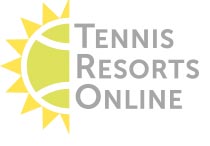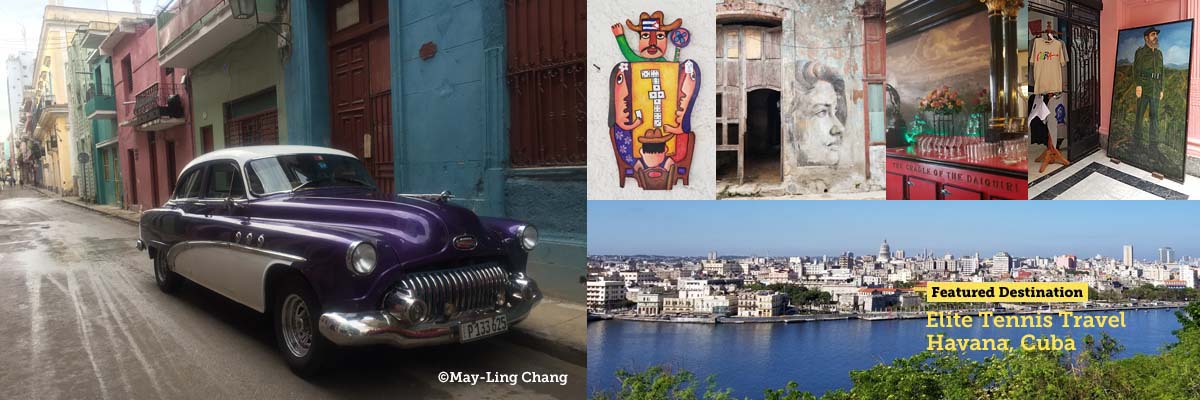
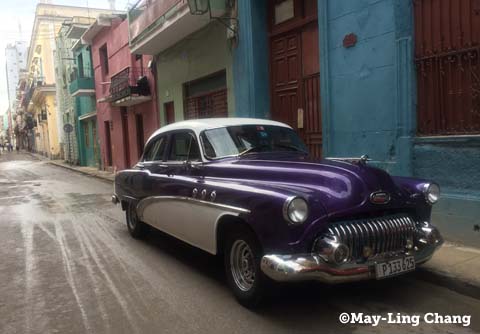
Tennis Can Be Your Passport To Cuba
When President Obama announced a thawing of relations with Cuba in 2015, my hopes of visiting—legally—this intriguing island finally appeared to be within reach. Like many people, I felt the need to go sooner rather than later, fearful that a boom in tourism would spur development in ways that could be detrimental to the island's character. I wanted to see the old Cuba, the haunt of Ernest Hemingway and Graham Greene, the time warp of 1950s automobiles. I wanted to stroll the streets of the once-walled Old Havana and drink mojitos at the celebrated Hotel Nacional and daiquiris, like Hemingway and Greene, at La Floridita. I wanted to hear the music made famous by the Buena Vista Social Club. But mostly I wanted to get beyond my own admittedly superficial images of the island nation and discover first-hand what Cuba was really all about.
![]() Unfortunately, before I could find an opening in my travel schedule, the U.S. elected a new President, one not at all happy with his predecessor's decision to ease the embargo. His reaction was to discourage U.S. citizens from visiting by tightening the travel rules—twice—and saddling them with red tape that made it more difficult to visit unless your trip met the guidelines for one of a dozen categories of travel. My first reaction was despair of getting to the island soon, until an opportunity arose from a quite unexpected quarter: it turned out that by traveling with Elite Tennis Travel and bringing donations of tennis clothing, equipment, tennis balls, and the like for the Cuban national tennis team, we not only met the criteria under "support for the Cuban people" but would be rewarded with the opportunity to meet and play with them. A love of tennis became our passport to Cuba.
Unfortunately, before I could find an opening in my travel schedule, the U.S. elected a new President, one not at all happy with his predecessor's decision to ease the embargo. His reaction was to discourage U.S. citizens from visiting by tightening the travel rules—twice—and saddling them with red tape that made it more difficult to visit unless your trip met the guidelines for one of a dozen categories of travel. My first reaction was despair of getting to the island soon, until an opportunity arose from a quite unexpected quarter: it turned out that by traveling with Elite Tennis Travel and bringing donations of tennis clothing, equipment, tennis balls, and the like for the Cuban national tennis team, we not only met the criteria under "support for the Cuban people" but would be rewarded with the opportunity to meet and play with them. A love of tennis became our passport to Cuba.
![]() So one day last October, seven of us—including Elite Tennis Travel's Lisa Scholtes—landed at José Martí International Airport in Havana for a five-day introduction to Cuba's history, culture, cuisine, and politics. After changing money, we headed to our hotel, a
So one day last October, seven of us—including Elite Tennis Travel's Lisa Scholtes—landed at José Martí International Airport in Havana for a five-day introduction to Cuba's history, culture, cuisine, and politics. After changing money, we headed to our hotel, a 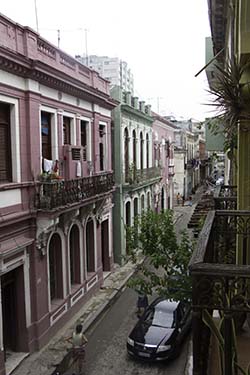 winsome casa particular called Casa Vitrales on a narrow, cobblestone street in Habana vieja (Old Havana). Once settled in, we boarded a van for an orientation to the city, cruising along broad boulevards, skirting the seawall—locally dubbed the "world's longest sofa" for all the people who gather atop it—and gazing at the nondescript government buildings and the American Embassy (where the U.S. government contends that some employees suffered brain damage and hearing loss as the result of some kind of high-tech surveillance) and the plaza and monuments where Fidel Castro delivered some of his most impassioned speeches. Fidel may have died, but his image survives on billboards, public monuments, and tourist memorabilia.
winsome casa particular called Casa Vitrales on a narrow, cobblestone street in Habana vieja (Old Havana). Once settled in, we boarded a van for an orientation to the city, cruising along broad boulevards, skirting the seawall—locally dubbed the "world's longest sofa" for all the people who gather atop it—and gazing at the nondescript government buildings and the American Embassy (where the U.S. government contends that some employees suffered brain damage and hearing loss as the result of some kind of high-tech surveillance) and the plaza and monuments where Fidel Castro delivered some of his most impassioned speeches. Fidel may have died, but his image survives on billboards, public monuments, and tourist memorabilia.
![]() Leaving the center city behind, we entered a different Havana, one of mansions and embassies lining the leafy streets of the Vedado and ending at the Hotel Nacional de Cuba. A McKim, Mead and White building modeled on Palm Beach's The Breakers, it was built in 1930 on the site of an 18th-century battery—two guns still remain—and attracted a Who's Who of bold face names, among them Winston Churchill, Jimmy Carter, Frank Sinatra, and Ava Gardner, to name a few. But it was also notorious as the venue in 1946 of the infamous Mob summit called by Lucky Luciano and Meyer Lansky (see The Godfather Part II). After strolling through the ornate lobby, we headed for the terrace and sipped classic mojitos while gazing out at the sea.
Leaving the center city behind, we entered a different Havana, one of mansions and embassies lining the leafy streets of the Vedado and ending at the Hotel Nacional de Cuba. A McKim, Mead and White building modeled on Palm Beach's The Breakers, it was built in 1930 on the site of an 18th-century battery—two guns still remain—and attracted a Who's Who of bold face names, among them Winston Churchill, Jimmy Carter, Frank Sinatra, and Ava Gardner, to name a few. But it was also notorious as the venue in 1946 of the infamous Mob summit called by Lucky Luciano and Meyer Lansky (see The Godfather Part II). After strolling through the ornate lobby, we headed for the terrace and sipped classic mojitos while gazing out at the sea.
![]() Thus primed, we hopped into several convertibles (a pink and white 1953 Oldsmobile in our case) for a trip back to the hotel and a chance to freshen up before following in the footsteps of Queen Sofia of Spain, Jay Z, and Nicole Kidman and dining at La Guarida, a "paladar", or family-run restaurant that had its own claim to celebrity as the setting for the Oscar-nominated film Fresa y Chocolate ("Strawberry and Chocolate"). Though the food, as we would find time and again in Cuba, was merely fine, the restaurant was visually memorable for its architecturally detailed facade, high-ceilinged rooms hung with crystal chandeliers and copious paintings, and multiple outdoor terraces.
Thus primed, we hopped into several convertibles (a pink and white 1953 Oldsmobile in our case) for a trip back to the hotel and a chance to freshen up before following in the footsteps of Queen Sofia of Spain, Jay Z, and Nicole Kidman and dining at La Guarida, a "paladar", or family-run restaurant that had its own claim to celebrity as the setting for the Oscar-nominated film Fresa y Chocolate ("Strawberry and Chocolate"). Though the food, as we would find time and again in Cuba, was merely fine, the restaurant was visually memorable for its architecturally detailed facade, high-ceilinged rooms hung with crystal chandeliers and copious paintings, and multiple outdoor terraces.
![]() The following morning we awoke to rain, which literally dampened our plans to hit with the Cuban National Tennis Team. They play out of the Cuban National Tennis Center, which until two years ago was in use but in desperate condition, with dilapidated courts, rusted fences, and sagging nets. That changed after a pro from Burlington, VT, Jake Agna, visited Cuba and was so impressed with the coaches and the kids that he returned home and set in motion a project to renovate the tennis complex. With the help of others (including the Serena Foundation), he raised money through the non-profit Kids On the Ball, and after complicated negotiations between the Cuban and U.S. governments succeeded in completing the first bricks-and-mortar project by a U.S. company since the Eisenhower Administration.
The following morning we awoke to rain, which literally dampened our plans to hit with the Cuban National Tennis Team. They play out of the Cuban National Tennis Center, which until two years ago was in use but in desperate condition, with dilapidated courts, rusted fences, and sagging nets. That changed after a pro from Burlington, VT, Jake Agna, visited Cuba and was so impressed with the coaches and the kids that he returned home and set in motion a project to renovate the tennis complex. With the help of others (including the Serena Foundation), he raised money through the non-profit Kids On the Ball, and after complicated negotiations between the Cuban and U.S. governments succeeded in completing the first bricks-and-mortar project by a U.S. company since the Eisenhower Administration.
![]() Hoping for a break in the rain, we headed out to meet the team—though not at the National Tennis Center,
Hoping for a break in the rain, we headed out to meet the team—though not at the National Tennis Center, 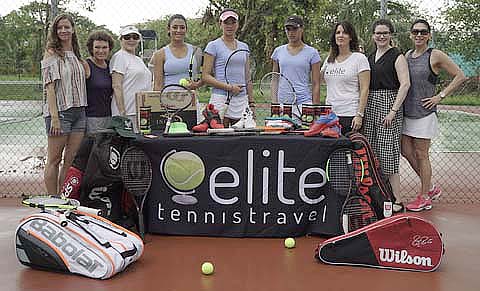 whose clubhouse, we were told, had plumbing issues. Instead we rendezvoused at the courts at Memories Miramar Hotel in Vedado. Intermittent rain made tennis impossible, but we did get introduced to some of the top-ranked girls and their coach and hand over the balls, racquets, string, clothing, and other paraphernalia we'd brought from home. Though their English was limited (or they were too embarrassed to use it), they communicated through their coach how much our donations mattered. We met up with them again and some of the boys' team the following morning, and despite continuing dreary weather, we managed an hour of mixed doubles with and against both teams. They were all delightful—and played excellent customer tennis.
whose clubhouse, we were told, had plumbing issues. Instead we rendezvoused at the courts at Memories Miramar Hotel in Vedado. Intermittent rain made tennis impossible, but we did get introduced to some of the top-ranked girls and their coach and hand over the balls, racquets, string, clothing, and other paraphernalia we'd brought from home. Though their English was limited (or they were too embarrassed to use it), they communicated through their coach how much our donations mattered. We met up with them again and some of the boys' team the following morning, and despite continuing dreary weather, we managed an hour of mixed doubles with and against both teams. They were all delightful—and played excellent customer tennis.
![]() If I'd wanted more tennis, my itinerary could have included matches with members who live or play out of the Diplomatic Club, ex-pats among them, but for such a short trip, I'd opted to spend the remaining time exploring Cuba in other ways. Elite Tennis Travel had carpentered together an itinerary that allowed the pursuit of special interests—one of the participants spent a morning scuba diving on reefs said to be among the most pristine in the Caribbean—but often we were together, taking a guided walking tour of Old Havana, visiting art galleries—including one at the home of the artists themselves—and following in the footsteps of Hemingway, from his recreated room in the Hotel Ambos Mundos and to La Floridita.
If I'd wanted more tennis, my itinerary could have included matches with members who live or play out of the Diplomatic Club, ex-pats among them, but for such a short trip, I'd opted to spend the remaining time exploring Cuba in other ways. Elite Tennis Travel had carpentered together an itinerary that allowed the pursuit of special interests—one of the participants spent a morning scuba diving on reefs said to be among the most pristine in the Caribbean—but often we were together, taking a guided walking tour of Old Havana, visiting art galleries—including one at the home of the artists themselves—and following in the footsteps of Hemingway, from his recreated room in the Hotel Ambos Mundos and to La Floridita. 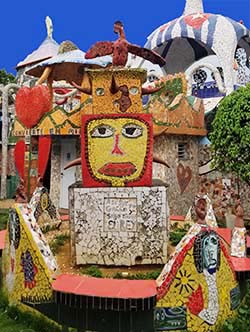 On another morning, we drove to the other side of the harbor to see the colossal sculpture of Jesus that seems to preside over the city from its hilltop perch and to clamber over the walls of the old fort, Forteleza de San Carlos de la Cabaña, which has a panoramic view of the city. And we made a foray into a neighborhood dubbed Fusterlandia for the Cuban artist José Fuster, who taken by the work of Spain's Gaston Gaudi, covered his house with a crazy quilt of intricate tilework in kaleidoscopic colors. Soon his neighbors followed suit creating an entire street of folk art.
On another morning, we drove to the other side of the harbor to see the colossal sculpture of Jesus that seems to preside over the city from its hilltop perch and to clamber over the walls of the old fort, Forteleza de San Carlos de la Cabaña, which has a panoramic view of the city. And we made a foray into a neighborhood dubbed Fusterlandia for the Cuban artist José Fuster, who taken by the work of Spain's Gaston Gaudi, covered his house with a crazy quilt of intricate tilework in kaleidoscopic colors. Soon his neighbors followed suit creating an entire street of folk art.
![]() I won't attempt to detail everything we saw and did. Woven into the schedule was time to wander on our own (the printed itinerary offered suggestions), shop, photograph, or pursue other interests, the last of which took me to two two famous watering holes: La Bodeguita del Media, the disputed birthplace of the mojito, and Hemingway's haunt La Floridita for daiquiris, both of which also had live music. Another stroll led serendipitously to a piano concert taking place in the 16th-century Basilica Menor y Convento de San Francisco de Asis. But without the local guides—among them a former cardiologist—we might not have had lunch at the Paladar Doña Eutimia, in a cobbled alleyway near Plaza de la Catedral, whose dishes, though traditional, a shredded pork in my case, were far and away the most delicious of the entire trip. Afterward, we toured the nearby Taller Experimental de Gráfica, a vast printmaking workshop where we watched Cuban artists at work producing high-quality etchings, lithographs, and woodcuts. They were happy to talk about their work, and the prices were very reasonable for such beautiful and original art that owed its inspiration to the artist's imagination rather than some slavish notion of what tourists would buy.
I won't attempt to detail everything we saw and did. Woven into the schedule was time to wander on our own (the printed itinerary offered suggestions), shop, photograph, or pursue other interests, the last of which took me to two two famous watering holes: La Bodeguita del Media, the disputed birthplace of the mojito, and Hemingway's haunt La Floridita for daiquiris, both of which also had live music. Another stroll led serendipitously to a piano concert taking place in the 16th-century Basilica Menor y Convento de San Francisco de Asis. But without the local guides—among them a former cardiologist—we might not have had lunch at the Paladar Doña Eutimia, in a cobbled alleyway near Plaza de la Catedral, whose dishes, though traditional, a shredded pork in my case, were far and away the most delicious of the entire trip. Afterward, we toured the nearby Taller Experimental de Gráfica, a vast printmaking workshop where we watched Cuban artists at work producing high-quality etchings, lithographs, and woodcuts. They were happy to talk about their work, and the prices were very reasonable for such beautiful and original art that owed its inspiration to the artist's imagination rather than some slavish notion of what tourists would buy.
![]() Everyone reconvened in the evening. Besides dinner, we got a taste of Cuban nightlife, spending one upbeat night at Legendarios del Guajirito, which features some of the Cuba's legendary musicians, singers, and dancers and had everyone on their feet, and a completely different evening at the very hot club Fábrica de Arte Cubano, a vast former factory where you never know quite what you'll find as you wander through a labyrinth of rooms, often connected by art-lined stairs and hallways, that might have a fashion show, a band, performance art, film, jewelry, clothing, whatever.
Everyone reconvened in the evening. Besides dinner, we got a taste of Cuban nightlife, spending one upbeat night at Legendarios del Guajirito, which features some of the Cuba's legendary musicians, singers, and dancers and had everyone on their feet, and a completely different evening at the very hot club Fábrica de Arte Cubano, a vast former factory where you never know quite what you'll find as you wander through a labyrinth of rooms, often connected by art-lined stairs and hallways, that might have a fashion show, a band, performance art, film, jewelry, clothing, whatever.
![]() As dense as this itinerary was, it lacked any excursions outside of Havana for any of us except the woman who scuba dived. Two places that had been on the original itinerary—Hemingway's farm, Finca La Vigia, and the Cojimar, the seaside neighborhood he used as the backdrop for The Old Man and the Sea and where he docked his boat Pilar—had both been damaged by Hurricane Irma a few weeks earlier and thus were inaccessible. And a trip to Viñales Valley, the so-called "Garden of Cuba", and a tour of tobacco farms, proved to be too far away for a day trip. There is only so much you can pack into a five-day, four-night trip. (For those interested in Viñales Valley, Scholtes suggests adding an extra day or two and staying there overnight.)
As dense as this itinerary was, it lacked any excursions outside of Havana for any of us except the woman who scuba dived. Two places that had been on the original itinerary—Hemingway's farm, Finca La Vigia, and the Cojimar, the seaside neighborhood he used as the backdrop for The Old Man and the Sea and where he docked his boat Pilar—had both been damaged by Hurricane Irma a few weeks earlier and thus were inaccessible. And a trip to Viñales Valley, the so-called "Garden of Cuba", and a tour of tobacco farms, proved to be too far away for a day trip. There is only so much you can pack into a five-day, four-night trip. (For those interested in Viñales Valley, Scholtes suggests adding an extra day or two and staying there overnight.)
![]() Before the trip began, Scholtes had been in touch with all of us about what sort of lodging we'd prefer, whether a traditional hotel, a villa, or something more intimate in Old Havana. By opting for the last we ended up in Casa Vitrales, a cross between a boutique hotel and a bed-and-breakfast. The supremely comfortable rooms—eight in all, on two levels—had 20-foot-high ceilings, air conditioning, and modern baths. Each morning, we walked up to the rooftop terrace for breakfast outdoors. The proprietor, Gustavo, is one of those people seemingly gifted with warmth and charm, and could not have been more hospitable. I'd stay there again if I came back.
Before the trip began, Scholtes had been in touch with all of us about what sort of lodging we'd prefer, whether a traditional hotel, a villa, or something more intimate in Old Havana. By opting for the last we ended up in Casa Vitrales, a cross between a boutique hotel and a bed-and-breakfast. The supremely comfortable rooms—eight in all, on two levels—had 20-foot-high ceilings, air conditioning, and modern baths. Each morning, we walked up to the rooftop terrace for breakfast outdoors. The proprietor, Gustavo, is one of those people seemingly gifted with warmth and charm, and could not have been more hospitable. I'd stay there again if I came back.
![]() The location in Old Havana was ideal. It meant I could walk out the door and wander these narrow, often colorful, cobblestone streets at will—the best way, I've found, to get a feel for a city. On our block, there seemed to be an astonishing disparity in prosperity. At the corner stood a well-kept building that, we were told, was a favorite of celebrities when they visited Havana. Across from us, another home, to judge from its facade and courtyard, appeared to be a bit run down, while the building next door to the hotel had no roof at all, only partial walls, and a padlocked entrance. Such derelict buildings were not unusual. Perhaps they been abandoned following the revolution and owners never returned, or perhaps because of the embargo building supplies to fix them up were in short supply or too expensive.
The location in Old Havana was ideal. It meant I could walk out the door and wander these narrow, often colorful, cobblestone streets at will—the best way, I've found, to get a feel for a city. On our block, there seemed to be an astonishing disparity in prosperity. At the corner stood a well-kept building that, we were told, was a favorite of celebrities when they visited Havana. Across from us, another home, to judge from its facade and courtyard, appeared to be a bit run down, while the building next door to the hotel had no roof at all, only partial walls, and a padlocked entrance. Such derelict buildings were not unusual. Perhaps they been abandoned following the revolution and owners never returned, or perhaps because of the embargo building supplies to fix them up were in short supply or too expensive.
![]() In my wandering elsewhere, I never saw signs of abject poverty or encountered people begging for food or money—the socialist government does evidently see to people's basic needs—but what few fruits and vegetables I saw, in markets or on vendors' carts, were neither varied nor of high quality. There are signs of change in the willingness of the government to allow private entrepreneurship, like family-run paladars or specialized retail businesses. That has opened up the economy and allowed some to prosper, though it's a bad sign when a cardiologist can earn a better living as a tour guide than as a doctor.
In my wandering elsewhere, I never saw signs of abject poverty or encountered people begging for food or money—the socialist government does evidently see to people's basic needs—but what few fruits and vegetables I saw, in markets or on vendors' carts, were neither varied nor of high quality. There are signs of change in the willingness of the government to allow private entrepreneurship, like family-run paladars or specialized retail businesses. That has opened up the economy and allowed some to prosper, though it's a bad sign when a cardiologist can earn a better living as a tour guide than as a doctor.
![]() We packed a lot into four-and-one-half days. It came to an end with a festive dinner at Paladar San Cristobal, a Creole restaurant in an elaborately and sometimes whimsically decorated and tiled old mansion that, like La Guarida, boasts a long list of celebrity clientele, among them Mick Jagger, Beyoncé, and President and Mrs. Obama. So our trip ended where it had begun, in a way, with the president who had opened the country.
We packed a lot into four-and-one-half days. It came to an end with a festive dinner at Paladar San Cristobal, a Creole restaurant in an elaborately and sometimes whimsically decorated and tiled old mansion that, like La Guarida, boasts a long list of celebrity clientele, among them Mick Jagger, Beyoncé, and President and Mrs. Obama. So our trip ended where it had begun, in a way, with the president who had opened the country.
Packages and Specials
Adult Tennis Camps
- Saddlebrook (Hopman) Tennis, Florida: Free Upgrade to 1-bedroom suite + Amenity Basket
- John Newcombe Tennis Ranch, Texas: Save $100 on any all-inclusive adult package
Junior Tennis Camps & Tournament Tours
- Julian Krinsky School of Tennis, Pennsylvania: $100 off resident camps; $50 off day camps
- Tennis: Europe and North America: $200 off package trips
Sponsors

Tennis with the Stars Camp and VIP Event, held March 5-9, 2018 at Omni Rancho Las Palmas in California. The week is a combination of outstanding tennis instruction, mingling with star players from the ATP and WTA tours, and watching the pros play up close and personal. This is the ultimate Indian Wells Cliff Drysdale Tennis Experience. For more information, please contact Katie Steck via email at k.steck@cliffdrysdale.com or phone 830-625-5911x208, or visit Tennis With the Stars |
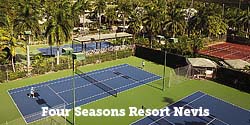
Stay Longer at Four Seasons Resort Nevis with a complimentary fourth night with every three consecutive paid nights. That extra night means more time for tennis at the Resort's award-winning tennis center. The 10-court complex features two new AstroTurf courts, along with four red clay, and four hard, making the facility one of only two in the region to offer three different playing surfaces. For reservations or information, please call 869-469-6238 or visit fourseasons.com/nevis |
Resort and Camp News
Kiawah's Roy Barth Retires
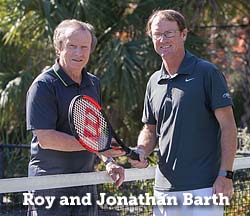 Kiawah Island Golf Resort's tennis director Roy Barth retired effective January 1. He had held that position for an incredible 41 years, having joined the resort when it opened in 1976. Over those decades he had built an award-winning program, scoring a No. 1 ranking on Tennis Resorts Online in virtually every year since 2005. Even before his retirement, Kiawah had honored his service and longevity by renaming the larger of the two tennis complexes the Roy Barth Tennis Center. Fortunately for guests, though Barth may be retiring, he is not leaving. His new title is Emeritus Tennis Director, which means he will still be on hand to teach and pass along his expertise. His son Jonathan, who has been Kiawah's Head Pro, will take over the director responsibilities.
Kiawah Island Golf Resort's tennis director Roy Barth retired effective January 1. He had held that position for an incredible 41 years, having joined the resort when it opened in 1976. Over those decades he had built an award-winning program, scoring a No. 1 ranking on Tennis Resorts Online in virtually every year since 2005. Even before his retirement, Kiawah had honored his service and longevity by renaming the larger of the two tennis complexes the Roy Barth Tennis Center. Fortunately for guests, though Barth may be retiring, he is not leaving. His new title is Emeritus Tennis Director, which means he will still be on hand to teach and pass along his expertise. His son Jonathan, who has been Kiawah's Head Pro, will take over the director responsibilities.
In other resort news, The Ritz-Carlton, Kapalua, on the Hawaiian island of Maui, has just completed what it calls a "transformative renovation." Now celebrating its 25th anniversary, the 463-room hotel now boasts newly transformed guest rooms, suites and residences, an enhanced lobby and pool experience, and new F&B outlet, Kai Café. Its location, on a knoll above the beach at Honokahua Bay, affords sweeping views of the ocean and sunsets. And tennis is as close as the 10-court Kapalua Tennis Garden, a short walk or shuttle ride away. … Curtain Bluff on the Caribbean island of Antigua opened for the season last fall 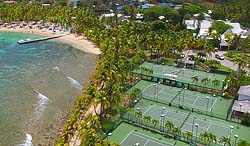 having undergone a $13 million refurbishment. The 72-room all-inclusive greeted guests—some 60 percent of whom are repeat visitors—with a redesigned entrance, updated public spaces, and rooms brightly refurbished with new tile floors and colorful fabrics. Its annual Antigua Tennis Week, an all-inclusive tennis party with Grand Slam winners Fred Stolle and Owen Davidson and Australian Open Champion Ross Case, takes place May 5-12, 2018. … An even more thorough makeover is underway at Horseshoe Bay Resort, the 7,000-acre property on Lake LBJ in the Texas Hill Country near Austin. Already complete is a total renovation of the 100 one-, two-, and three-bedroom villas. There's also a brand-new Whitewater 360 Sports Club, which has 360-degree views of the Whitewater putting course as well as 16 big-screen televisions above the bar and tuned to sporting events. At the tennis complex, the eight hard courts were resurfaced, the former artificial grass courts were replaced by two red-clay courts (keeping the number of red clay at six after the loss of two others), and pickleball lines were added to the three kids' courts. Attention has now turned to a remodel of the 249 rooms in the resort tower. That will be followed by new waterfront bar and grill, kids club, marina slips, yacht club pool bar, and a bayside spa as well as the updating of the Ram Rock and Apple Rock golf courses. … Hawk's Cay Resort on Florida's Duck Key, one of the low-lying properties damaged by Hurricane Irma last fall, has announced plans to reopen in stages beginning in the second quarter of 2018. As details become available, we'll post them here, including information about the Drysdale Tennis programs there.
having undergone a $13 million refurbishment. The 72-room all-inclusive greeted guests—some 60 percent of whom are repeat visitors—with a redesigned entrance, updated public spaces, and rooms brightly refurbished with new tile floors and colorful fabrics. Its annual Antigua Tennis Week, an all-inclusive tennis party with Grand Slam winners Fred Stolle and Owen Davidson and Australian Open Champion Ross Case, takes place May 5-12, 2018. … An even more thorough makeover is underway at Horseshoe Bay Resort, the 7,000-acre property on Lake LBJ in the Texas Hill Country near Austin. Already complete is a total renovation of the 100 one-, two-, and three-bedroom villas. There's also a brand-new Whitewater 360 Sports Club, which has 360-degree views of the Whitewater putting course as well as 16 big-screen televisions above the bar and tuned to sporting events. At the tennis complex, the eight hard courts were resurfaced, the former artificial grass courts were replaced by two red-clay courts (keeping the number of red clay at six after the loss of two others), and pickleball lines were added to the three kids' courts. Attention has now turned to a remodel of the 249 rooms in the resort tower. That will be followed by new waterfront bar and grill, kids club, marina slips, yacht club pool bar, and a bayside spa as well as the updating of the Ram Rock and Apple Rock golf courses. … Hawk's Cay Resort on Florida's Duck Key, one of the low-lying properties damaged by Hurricane Irma last fall, has announced plans to reopen in stages beginning in the second quarter of 2018. As details become available, we'll post them here, including information about the Drysdale Tennis programs there.
